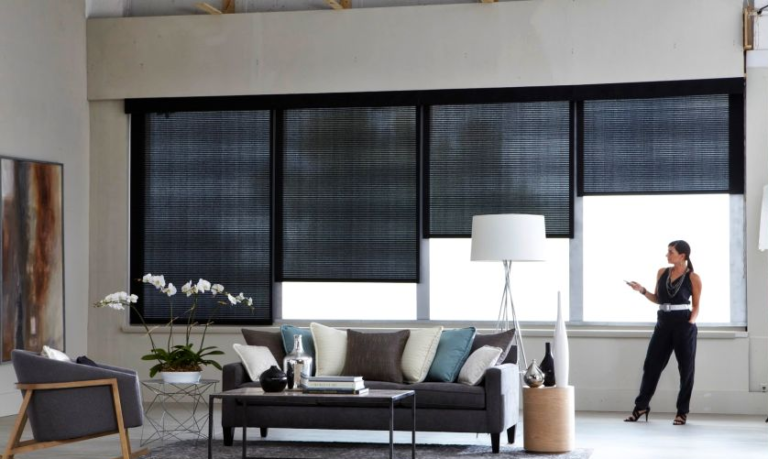A smart home is a home that features smart technology to provide an automated environment. Smart home automation, for example, allows users to control their homes’ lights as well as other functions like smart appliances and security systems using smartphones, tablets, laptops, watches, smart speakers (like Amazon Alexa or Google Home), and smart TVs.
Today, we’ll go over the many forms of motorized window coverings that smart home devices may control, including motorized custom shades, motorizing blinds, Roman shades, cellular shades, and plantation shutters. Before getting into it, we’d just like to remind you that these motorized window coverings can all be controlled with a remote control, wall mount, or manually.
Motorized Blinds
Motorized blinds are automated vertical blinds that are operated by remote control and powered by motors built into the wall behind them. Because the motors are located behind the blinds, your smart home devices must directly communicate with these motors in order for them to function when you press the “up” or “down” button on your smartphone.
Motorized Shades
Motorized shades may move up or down vertically, but since their motors are within them, they generally don’t have a motor on the wall behind them. The smart home gadget you use to control your smart home will connect directly with the motor that is within these window coverings and then send remote control commands from there to raise or lower your window covering. As a result, an Alexa-enabled hub, for example, maybe required since it may function as a repeater to assist smart home devices to communicate with motorized shades.
In conversations, generally, the terms “motorized shades” and “motorized blinds” are used interchangeably. However, because we have made the distinction, we’d just like to mention that technically, motorized blinds have horizontal slats while motorized shades are usually a single piece of fabric. That is the most significant difference between these two sorts of motorized window coverings.
Roman Shades
Roman shades are vertical-moving window coverings that work similarly to Venetian blinds, although they use wires rather than strings. You may raise or lower your window covering by pressing a button on a panel near the shade and controlling Roman shades from your smart mobile device. This technique will usually also allow you to tilt your window covering in order to regulate how much light enters through it.
Because smart home devices should already have direct access to your blinds’ motor and cord-operating mechanism, smart home hubs are usually not needed for this sort of smart home automation. They’re nice to have for voice control, and many people choose them.
Cellular Shades
Cellular shades, like Roman shades, are made of translucent fabric that is suspended between two layers. They’re also thicker and more insulating than Roman shades because of their internal honeycomb design. In addition to being able to raise and lower them by pressing wall-mounted buttons near the location, smart home technologies can send remote control signals directly to cellular shades in order to alter how much light enters a window. A smart blinds system may not require a voice control smart home hub if your smart blinds’ motor has direct access to your smart blinds’ mechanism.
Plantation Shutters
Plantation shutters are different from traditional blinds in that they do not roll up or down. They also typically open on the side rather than from above. Plantation shutters can be controlled with smart home devices that have direct access to your smart blinds’ motor and mechanism for opening the blinds via a smart home hub, which is not required for smart home devices to control your plantation shutters because they already have direct access to your smart blinds’ motor.
Summary
Smart blinds and smart shades can typically be controlled by smart home devices that have direct access to the smart window covering’s the motor and cord-operating mechanism through remote control signals and voice commands. To access these abilities, you simply integrate your smart shades and smart blinds with your smart home hubs and smart devices.
Motorized window treatments offer convenience, time savings, energy cost and consumption savings, privacy, and security. Smart home control integration and remote operation are the way of the future, and blinds are just another small step towards making life a lot easier and more enjoyable for homeowners.
Read More: A Brief Summary of Several Kinds of Blinds
